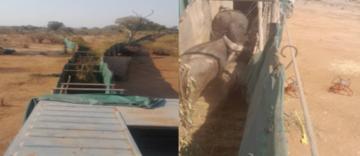Sidinda CAMPFIRE Wildlife Conservancy has done it again

A Beacon of Hope for Community-Based Conservation
Tucked away in the picturesque Hwange District along the mighty Zambezi River, Sidinda Ward has undergone a remarkable transformation from a poaching-devastated area to a thriving wildlife conservancy. This success is attributed to tireless efforts of the Sidinda CAMPFIRE Committee and the community it represents, Hwange Rural District Council, Zimela Safaris and the CAMPFIRE Association.
A New Lease on Life
In 2018, the conservancy received a donation from the Government of Zimbabwe of plains game that included 20 kudus, 20 zebras and 18 waterbucks as well as 100 buffaloes, through the Sustainable Wildlife Economy project (https://campfirezimbabwe.org/article/sidinda-campfire-wildlife-conservancy). This wildlife introduction marked the beginning of a new era for Sidinda. In 2024, the conservancy secured an additional 150 buffaloes to boost the gene pool of an already existing population of 130, (after an estimated 30 calves were born,) bringing the total population to a thriving 280 buffaloes. These antelope populations provide the basis for sustainable hunting by the safari operator and will hopefully also attract photographic tourism to the area in future.
The Sidinda community retains 100% of the revenue from the plains game hunted within their ward, while they have always received 50% of the total revenue generated from elephant hunts, as per CAMPFIRE regulations. Starting in 2024, the dividends sharing schedule has been revised for elephant hunts to increase the community’s share. These changes have marked a turning point for Sidinda, which is looking to expand its wildlife population and increase the benefits delivered to community members.
Partnerships and Progress
The conservancy's success is rooted in its partnerships with key stakeholders that include community, Hwange Rural District Council, CAMPFIRE Association, Zimbabwe Parks & Wildlife Authority, the Department of Veterinary Services and Zimela Safaris.
With support from the Kavango–Zambezi Transfrontier Conservation Area Secretariat, through the CAMPFIRE Association, the conservancy received funding for fencing a 40,000-hectare area which has been set aside for game. The safari operator is co-financing the project, which is now 90% complete. Communities are participating in the project through provision of labour in various areas, a total of 35 community members are employed by the conservancy -15 people are employed on the anti-poaching team and 20 are employed in other positions at the hunting camp.
The wider community has benefited significantly from CAMPFIRE proceeds which have been used to build infrastructure over the years, such as the Makala and Dobolo early childhood development centres, as well as plumbing and electrification for Lumbora Secondary School. Many more projects are in the pipeline.
To improve communication within the ward, CAMPFIRE committee procured smart phones for their employees working on the ground. This initiative has greatly improved the response time to human-wildlife conflict incidences.
In the meantime, Zimela Safaris have drilled and equipped seven boreholes for the community as part of their social corporate responsibility commitment. These boreholes provide clean, potable and safe water for people and livestock use, thus reducing competition and strain on water resources, promoting coexistence with wildlife and assisting with climate change adaptation. The safari operator is also planning to build a health clinic in the Lumbora area, with plans awaiting approval by the local authority before construction begins.
Helping communities overcome challenges
Rural communities in Zimbabwe face recurring droughts associated with climate change and human-wildlife conflict, both of which threaten their livelihoods and food security. The Sidinda conservancy is helping its communities to implement effective mitigation measures to reduce the conflict and competition over natural resources. The restocking project in 2018 and 2024 shall improve food security and livelihoods for the communities, with future benefits expected from hunting and photographic tourism ventures.
The conservancy's activities benefit approximately 1000 households, providing a vital source of income and improving their overall quality of life. This community-centred approach ensures that conservation efforts are aligned with the needs and aspirations of the local population as well as achieving sustainable development goals at the local level.
Sidinda’s past success and bright future serve as a model for community-based conservation in Zimbabwe and elsewhere. The Sidinda community initiative showcases the power of collaboration and determination towards sustainable wildlife management and conservation. Thereby serving as a beacon of hope for conservation efforts across the sub-continent.
